Why Indigenous Students Are Fighting to Wear Tribal Regalia at Graduation
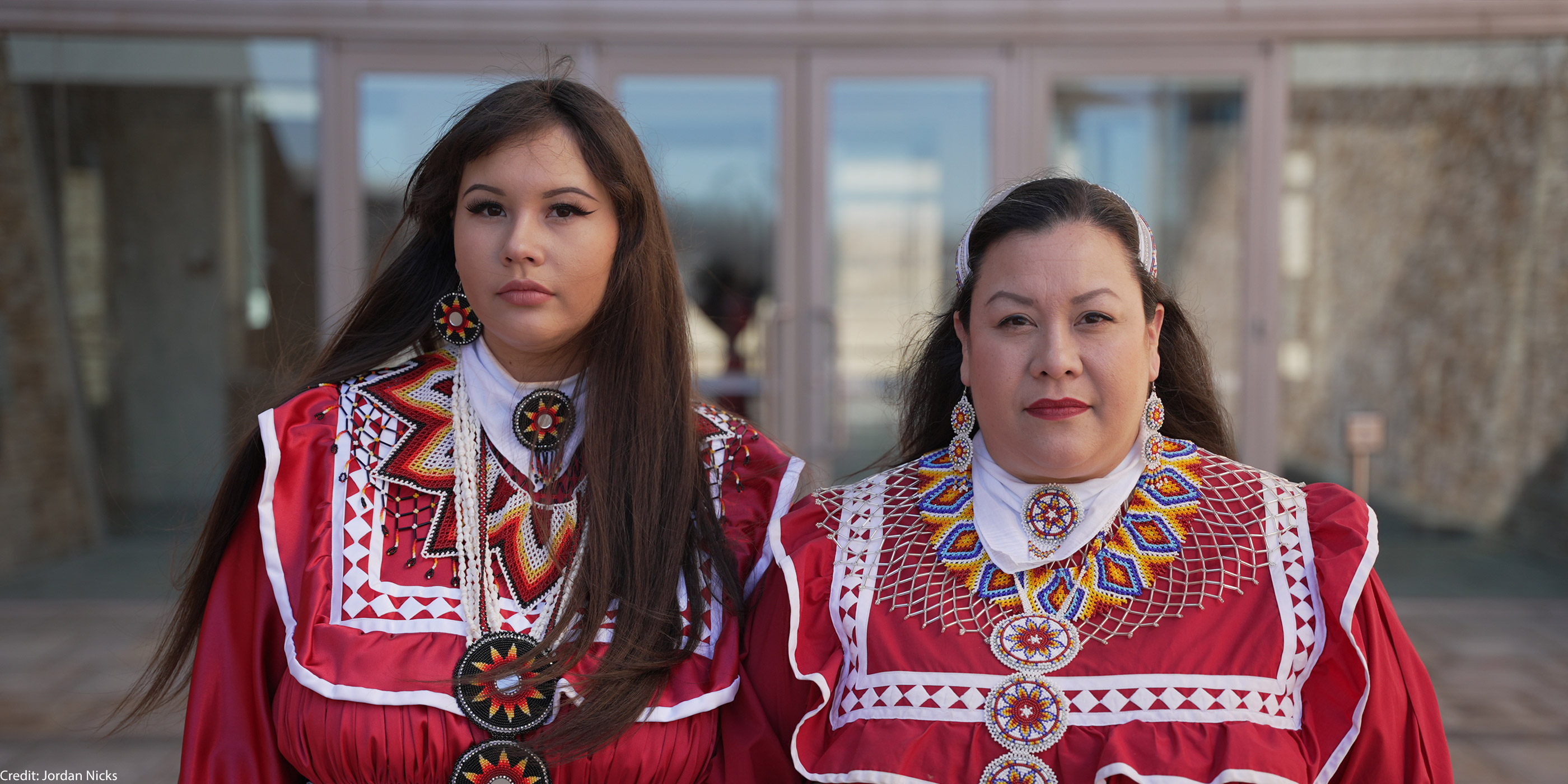
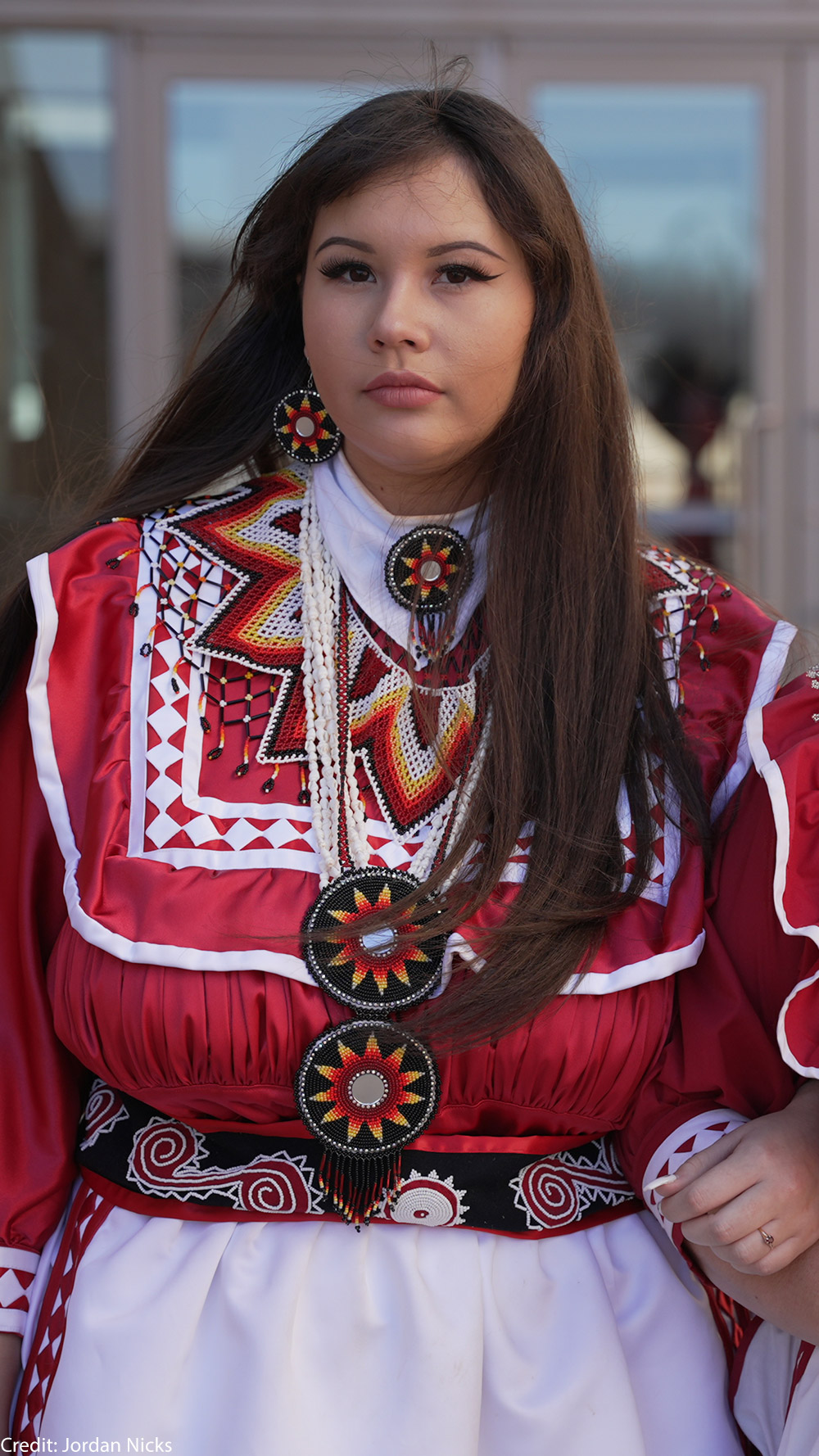
ItтАЩs graduation season, and students are getting ready to put on their caps and gowns to celebrate this rite of passage. For many Indigenous students, this milestone event cannot be fully realized without wearing traditional tribal regalia, which are sacred markers of achievement, tradition, and connection with ancestors.
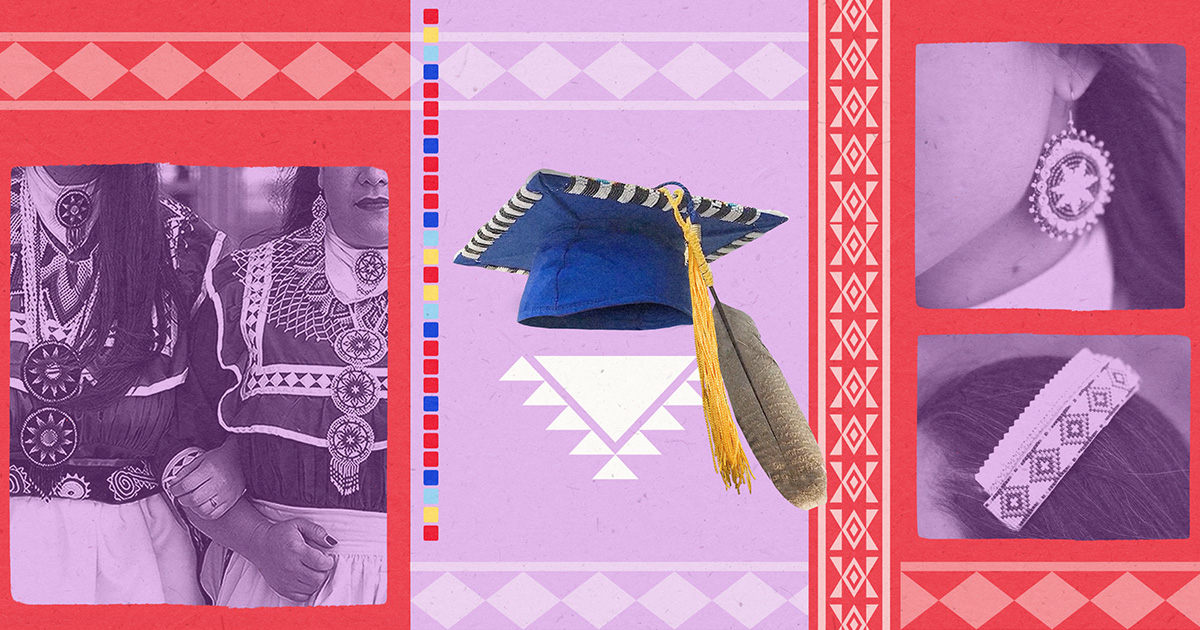
Protecting Indigenous Students' Right to Wear Tribal Regalia
Indigenous students should be able to celebrate their graduation and their cultural and religious heritage.
Source: └╧░─├┼┐к╜▒╜с╣√
In some states, however, students are prohibited from displaying their Indigenous identity through tribal regalia, such as feathers or beads, braids, or long hair. Schools have historically been used as a tool to forcibly assimilate Indigenous children, making todayтАЩs bans even more harmful to Indigenous communities. This history makes tribal regalia a source of empowerment for Indigenous students as they reclaim their identity and honor their ancestors.
These interviews have been edited and condensed for clarity.
The Meaning of Tribal Regalia
Tribal regalia can take many forms and differs from tribe to tribe. Each detail signifies a part of the tribeтАЩs history, traditions, or beliefs тАФ including colors, beadwork, and patterns тАФ and it often takes many hours of work and several community or family members to produce an item. Regalia is usually handed down from elders and is worn for special occasions like graduation ceremonies.
тАЬOur regalia has stories in it. It tells us about who we are as people. It tells the story of us and it allows us to show the world: Here's who I am, and I'm proud to be Indigenous Choctaw.тАЭ тАФ Isabella, Choctaw Nation
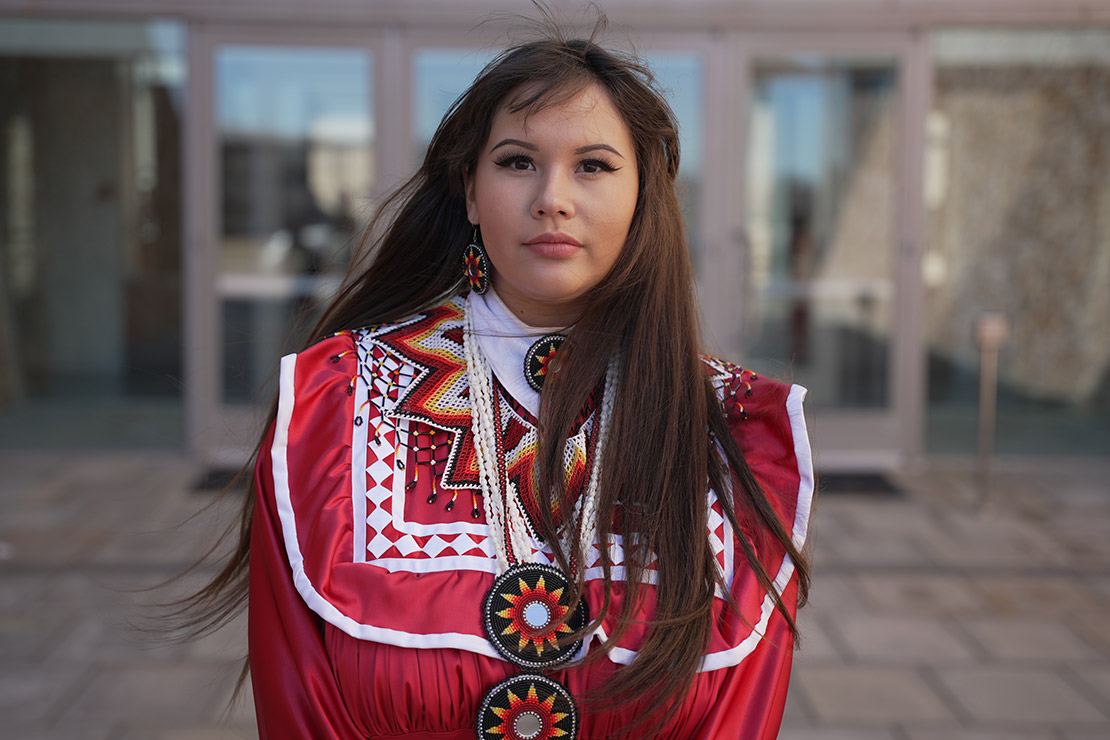
Isabella Blu Aiukli Cornell
Credit: Jordan Nicks
тАЬIn many of our tribes, tribal regalia are sacred items, like you receive a feather for an accomplishment, for something you earn. It isn't something that you simply take or wear. Somebody has to give it to you. And it signifies this milestone, something that you have really achieved.тАЭ тАФ Sarah, Choctaw Nation
тАЬEveryone has a story to tell about the clothing, shoes, and hair that we choose to wear. When I graduated from Saint Francis Indian School, I was honored with the plume. Our babies got their Lakota names. They were honored with poems.тАЭ тАФ Norma, Rosebud Sioux
тАЬIt's important to me to be proud and to show the sacrifices my ancestors made and show the younger generation that they don't have to be scared. ItтАЩs okay to be different from everybody else and to show off your tribe.тАЭ тАФ Nataya, Choctaw Nation
тАЬWhat's super cool about our regalia is that it takes different community members to make it. Maybe you make your collar necklace, and maybe your mother is making your moccasins or your auntie is making your shawl. It's like you are carrying your community with you when you wear your regalia, and there's something about it that gives you a sense that you're a part of something bigger, that you're a part of a community and a people that have been here since the beginning that have survived atrocities that I will never understand.тАЭ тАФ Sarah, Choctaw Nation
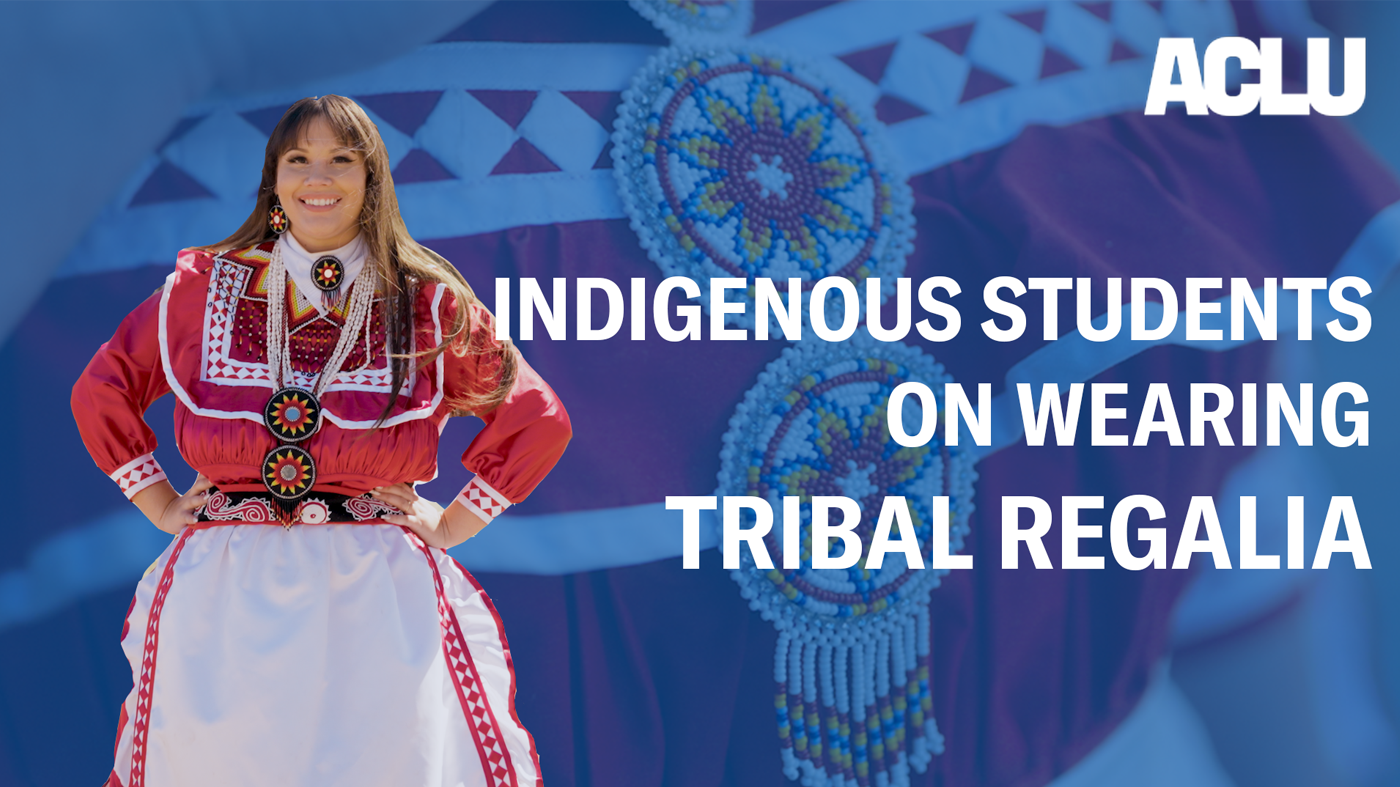
тАЬThis diamond trim that goes all around my apron and the trim of my dress and my cuffs and around my collar ... reflects the Diamondback rattlesnake. Choctaw hold a really high regard for this snake, because it was very fundamental in our upbringing as a culture. We were farmers back in the day and would grow our crops to sustain our people. Pests like mice would get into our crops, but the snake would feed on the mice. So we hold it in high regard because it protected our food. We honor it as a protector of our people.тАЭ тАФ Isabella, Choctaw Nation
How Tribal Regalia Bans are Being Enforced in Schools
тАЬMy little brother went to a Christian academy to start going to school there, but they told him his hair was too long and he needed to cut it to be able to go to school there. ... They said it was a distraction. So we left the school and did not go back because it wasn't an option to cut his hair at the time. And he was still very little.тАЭ тАФ Nataya, Choctaw Nation
тАЬI have a Matriarch sister who graduated, and somebody actually pulled her feather out while she was at graduation, like before she walked the stage, they took it.тАЭ тАФ Sarah, Choctaw Nation
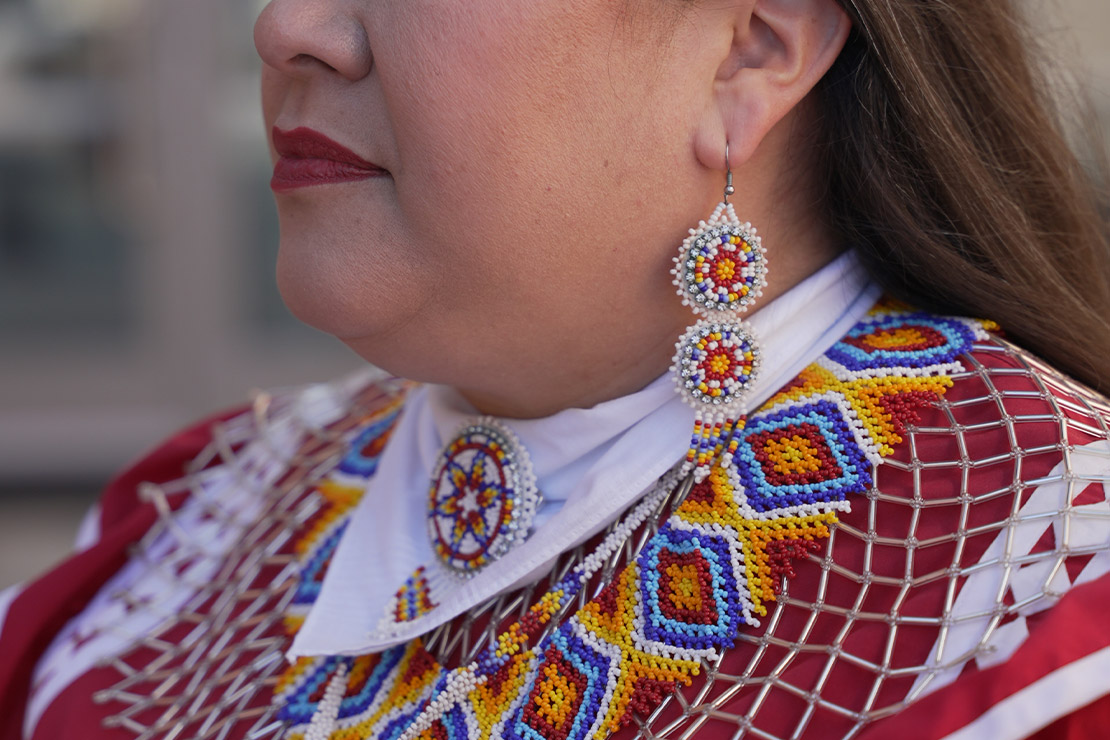
Sarah Adams-Cornell
Credit: Jordan Nicks
тАЬI was considering maybe wearing a feather or having my cap beaded because I had heard stories about people who didn't get to have that, people who had to hide that part of themselves, and people even going as far as maybe taking it from them, which is one of the most disrespectful things that you could do to an Indigenous person. So that fear was definitely in me at this time. Might that happen to me? Might that be something that I have to worry about?тАЭ тАФ Isabella, Choctaw Nation
тАЬIt's heartbreaking that our kids have to overcome barriers in their education, that they just can't go and be who they are.тАЭ тАФ Sarah, Choctaw Nation
A Legacy of Systemic Erasure in Schools
Up until 1960, the federal government worked with churches to implement an Indian Boarding School policy, which removed Indigenous children from their families and sent them away for re-education in boarding schools far from home. The stated intent of this program was to тАЬkill the Indian, save the man.тАЭ As such, children would be тАЬ for speaking their native language, banned from acting in any way that might be seen to represent traditional or cultural practices, stripped of traditional clothing, hair and personal belongings and behaviors reflective of their native culture.тАЭ By 1925, children had been sent to these schools тАФ nearly 80 percent of school-age Indigenous children.
Today, Indigenous history is still being erased in schools, where most curriculums do not include Indigenous genocide and erasure despite its centrality to U.S. history.
тАЬMy grandmother was put in costume native clothing for people who would come to the boarding school so that she would look like the stereotypical pan-Indian person. So to be able to wear our actual clothes, to be able to represent as a Choctaw person was huge. It was pivotal in my identity.тАЭ тАФ Sarah, Choctaw Nation
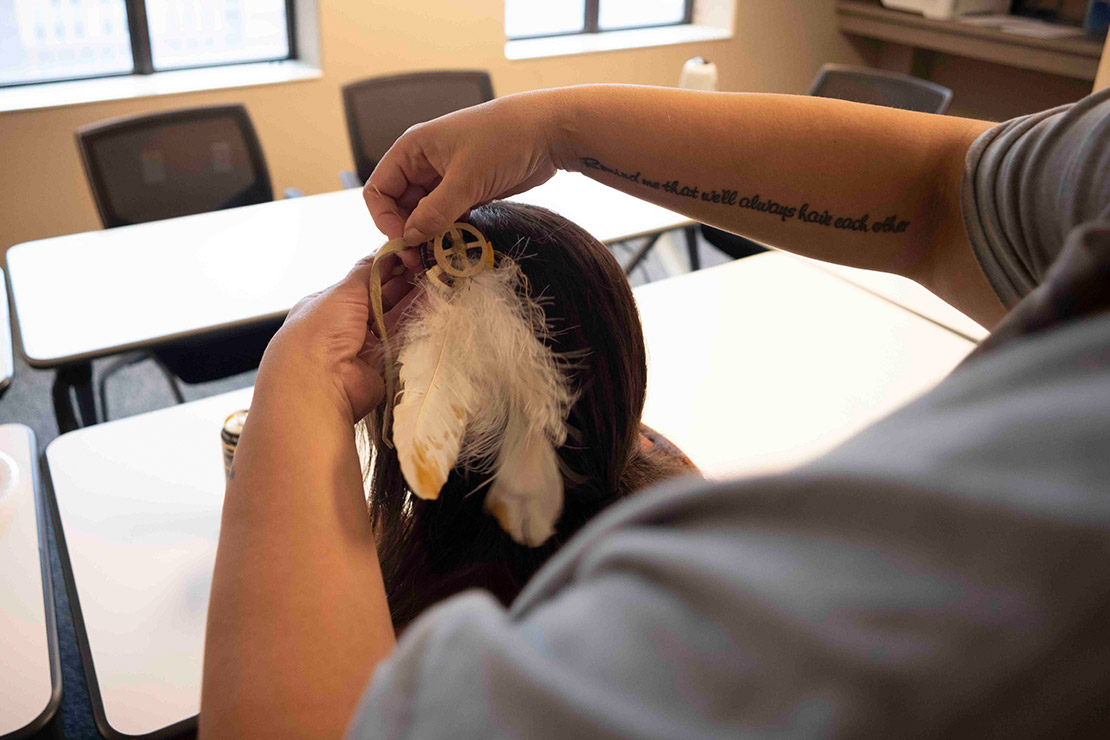
Alice Johnson putting a feather in her child's hair.
Credit: Doug Barrett
тАЬIn 1879, when boarding schools became mandatory, Indigenous students were given military style quills in place of their regalia. Their hair was cut. They were given Christian names. This was the start of American genocide.тАЭ тАФ Norma, Rosebud Sioux
тАЬWhenever I think about this issue of people not wanting Indigenous kids to express their Indigeneity at graduation, it reminds me that these systems were never put in place with our well-being in mind тАж It wasn't until my mom's generation that the Freedom of Religion Act was passed, and they're the first generation that were allowed to practice their culture and ceremonial ways without going to jail for it. So it really puts things into perspective when we still encounter these issues to this day, because we're not as far along as we think we are.тАЭ тАФ Isabella, Choctaw Nation
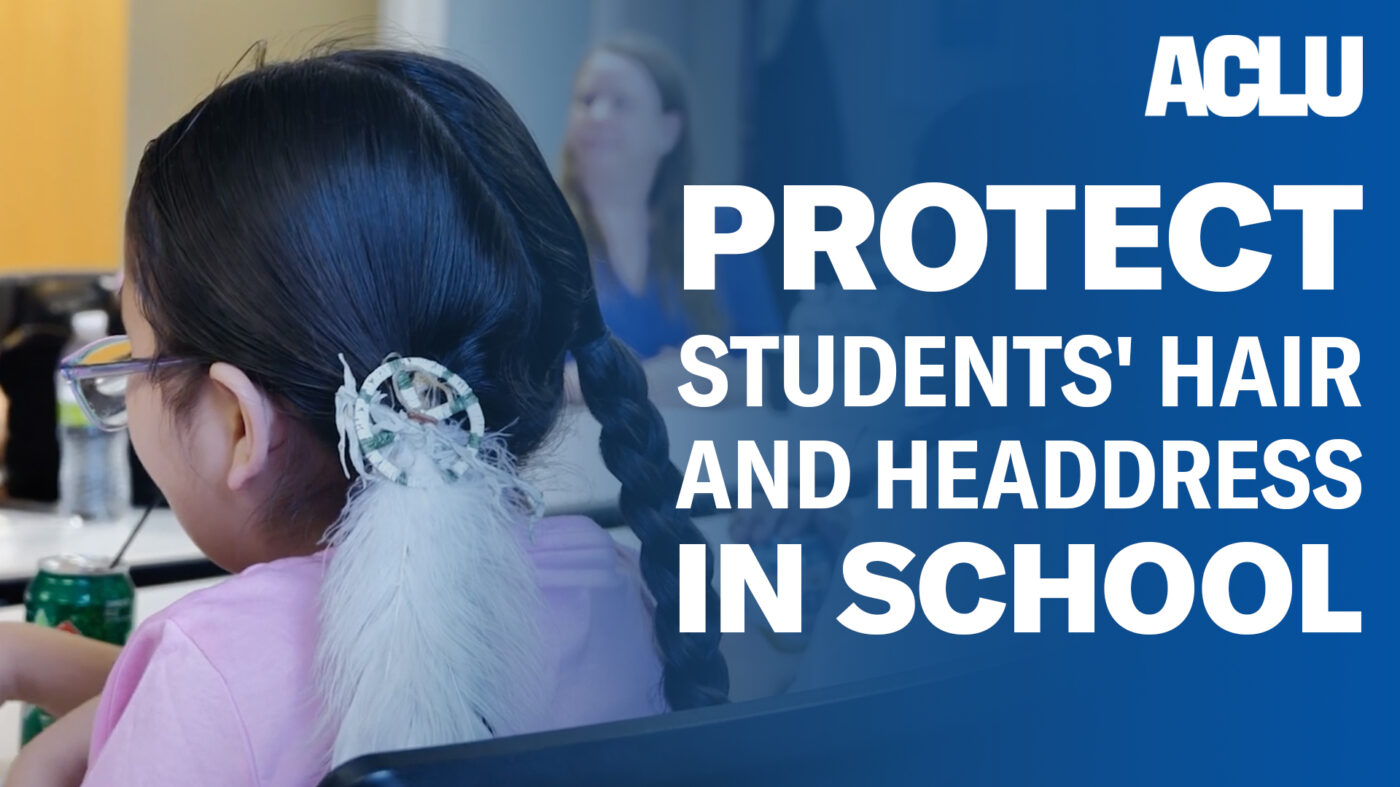
тАЬI wished I was taught more about, like, how we got to this point where we're one of the more impoverished places in this country, you know? How did that happen and what caused that? I do know some of the answers but I didn't learn it from school. I really had to self-educate.тАЭ тАФ Wyatt, Ochete Shakowi Nation
тАЬI was born in 1978, and that's when it was finally legal for us to speak our language, to sing our songs, to practice our ceremonies without going to jail. So this reclamation of identity is huge.тАЭ тАФ Sarah, Choctaw Nation
Why Graduation Matters in the Fight to Wear Tribal Regalia
тАЬThis is a day of celebration for these students. And whenever a feather is given in these communities, it's one of the highest honors that you can bestow upon someone. And itтАЩs important to show your community this honor, to show people that your community is behind you and you have this honor. тАж And whenever we allow these kids to express themselves, we raise them to be strong and we raise them to be proud of who they are. So it's incredibly important that we're allowed to do this on this day. тАФ Isabella, Choctaw Nation
тАЬIt makes me feel proud and ambitious.тАЭ тАФ Nataya, Choctaw Nation
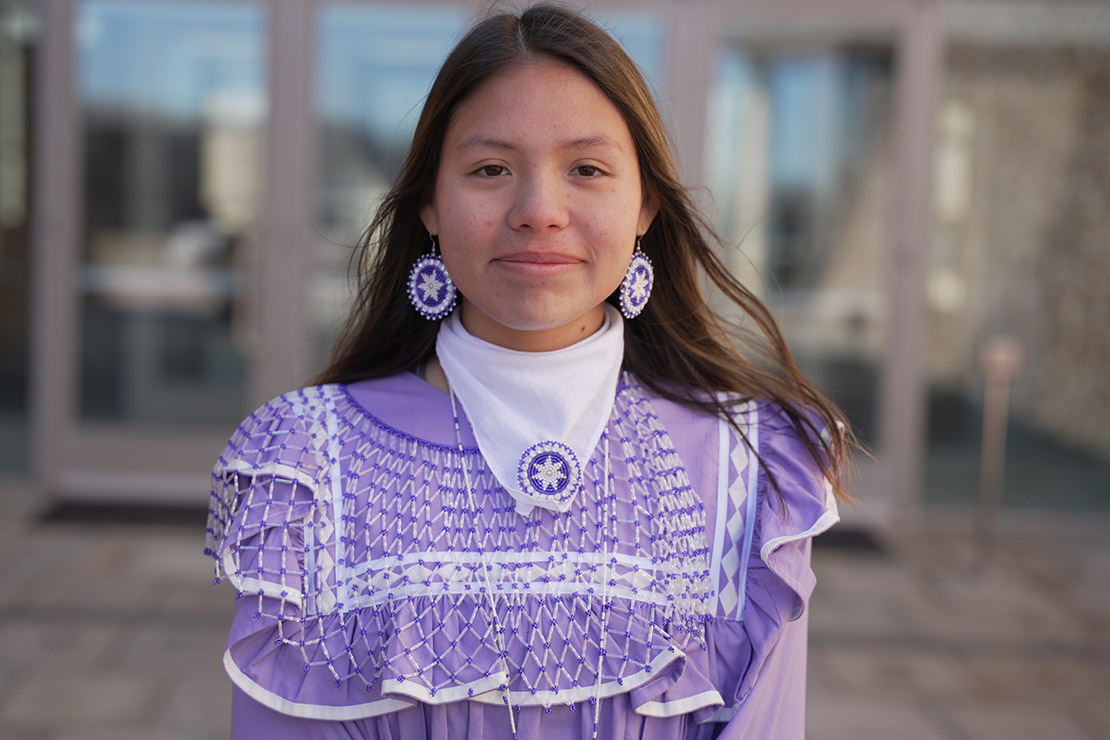
Nataya Meashintubby
Credit: Jordan Nicks
тАЬItтАЩs something that will be pivotal for them, something that will mean something to them when they are old and gray, when they're looking at their memories of their education, of their childhood. And they will point back and they will look at that picture of themselves graduating and being fully Indigenous with their feather, with their beaded cap in their regalia in whatever way that they're choosing to express themselves.тАЭ тАФ Sarah, Choctaw Nation
тАЬRepresenting yourself in your culture is an honor and everybody should be able to do it.тАЭ тАФ Isabella, Choctaw Nation
Sending a Message to Lawmakers and Non-Indigenous Communities
The └╧░─├┼┐к╜▒╜с╣√ is working in states across the country to stop tribal regalia and hair bans, including in Nebraska, where we on behalf of Alice Johnson and Norma LeRoy, whose two childrenтАЩs hair was cut by a school employee in violation of their traditional and religious Lakota beliefs. In Nebraska, weтАЩre asking the state legislature to pass LB 630, a bill that would explicitly prohibit discrimination based on studentsтАЩ racial, cultural, or religious attributes, including their hair, headdress, and tribal regalia. And in Oklahoma, weтАЩre advocating for SB 429, new legislation that would allow students enrolled in certain schools or institutions to wear tribal regalia during graduation ceremonies.
тАЬUnderstand that everybody has their own beliefs, their own cultures, their own religions, and not everyone celebrates accomplishments wearing suits and ties.тАЭ тАФ Alice, Rosebud Sioux.
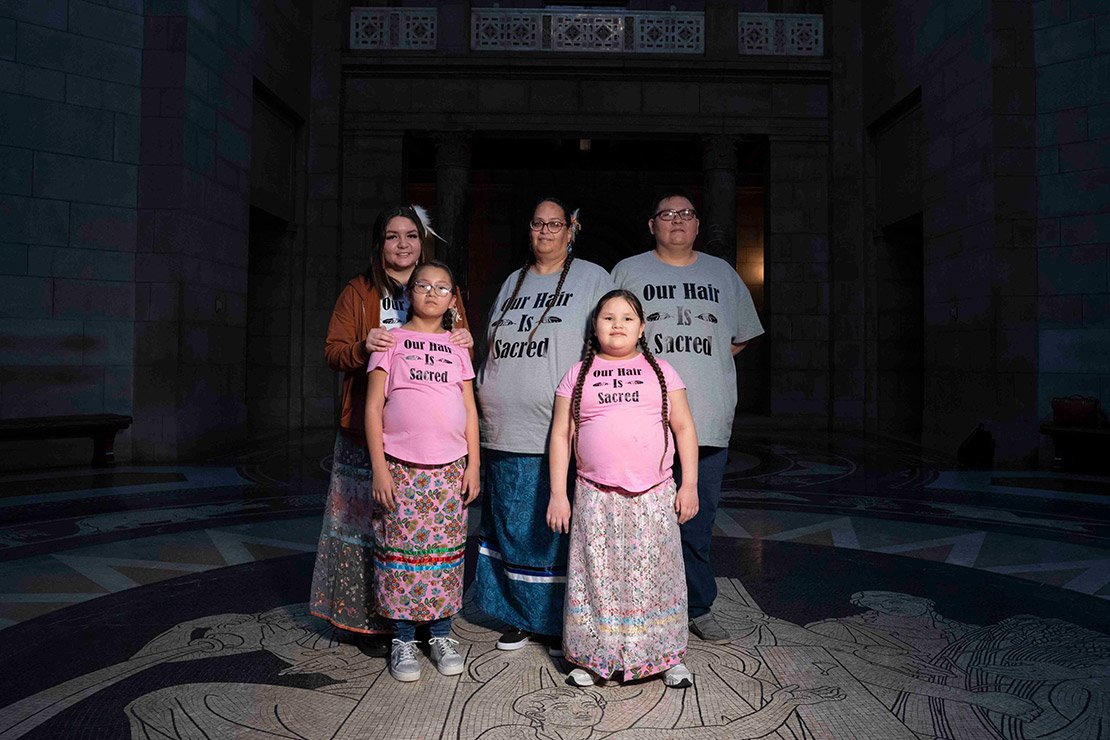
Back Left in Grey: Alice Johnson and Norma Leroy
Credit: Doug Barrett
тАЬEveryone has an identity. Who we are. It doesn't matter what race. We should be given the right to express that.тАЭ тАФ Norma, Rosebud Sioux
тАЬWe are only bolstering our community when we have healthy children, when we have children who are tied to their cultural ways. That only strengthens the community. And when we have healthy kids and strong kids, we have a stronger state, we have a healthier community, and there is nothing but goodness in that.тАЭ тАФ Sarah, Choctaw Nation
тАЬSince the American genocide in the 1700s, we've been fighting for who we are, fighting for what we believe in, and fighting for our ceremonial practices. And through it all, we've shown to be resilient people, strong people. We've overcome everything that the government has thrown at us. We have our beliefs, our cultures and religions, our ceremonies and our connections with our ancestors. We carry our names proudly, and we are compassionate, humble people. And we only want what's fair, respect who we are, respect our beliefs and respect what we live in practice.тАЭ тАФ Alice, Rosebud Sioux
тАЬWe're still here and we still deserve a voice, you know, and we still deserve to be talked about. And like, you can't hide from us that what happened happened. You know, let's learn from it. Let's really learn. Because a society that doesn't learn from their history is doomed to repeat it. And so why are we hiding from what happened? Let's take it and let's learn from it.тАЭ тАФ Wyatt, Ochete Shakowi Nation
тАЬThe fact that we get to live in a time right now where reclamation is happening is exciting. I hope that we all get to be a piece of that, whether that's by emailing our legislators, talking to them, explaining what regalia is encouraging them to support our community and be a part of this celebration. I can't wait to see all of these kids walking across the stage and beaming. It's going to be a good day.тАЭ тАФ Sarah, Choctaw Nation
тАЬWe should be allowed to express who we are. We shouldn't have to hide who we are on this day. So please listen to us when we're saying these things and please genuinely take it to heart and consider it, because this is something that Indigenous students need and it doesn't hurt anybody.тАЭ тАФ Isabella, Choctaw Nation

